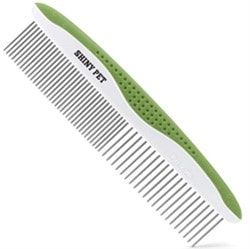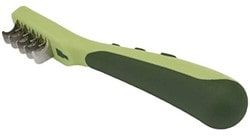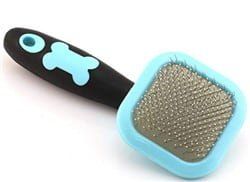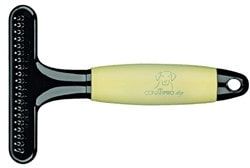Brushes, Tools
PetPom

The
Pomeranian
Information
Center
Best Brushes and Grooming Tools for a Pomeranian
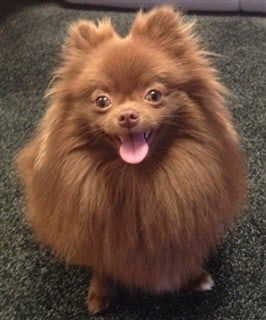
Fi Fi, at 1 year old, photo courtesy of Amanda Perkins
There are over 200 different dog breeds and a since there is such a wide variety of coat type (hair vs single layer of fur vs double layer of fur, and straight, wavy, or curly), length (from very short to very long and everything in between), and texture (wiry, silky, wooly, water-resistant, etc.), there is an extensive variety of canine grooming tools.
If the wrong tools are used on a Pomeranian, they will be ineffective at best. And unfortunately, at worst, they can completely destroy the coat.
So, this article will cover the best type of combs, brushes, and other grooming tools for Pomeranians. We will discuss what each one is used for, when to use it, and how to use it. You will find that you do not need a lot of grooming tools for a pet Pomeranian, you just need the right ones.
Don't want to read the details and just want to know what to grab?
Jump to 'The 6 Best Grooming Tools for a Pomeranian'.
The Elements that Affect Choice of Grooming Tools
Before we dive into what sort of brushes and other tools work best with Pomeranians, it can help if you understand exactly what type of coat a Pomeranian has since this is what determines what needs to be used.
- The breed in general, as adults, has a double coat of fur. There is a very dense, tightly-packed, and soft inner layer (known as the undercoat) and a long outer layer of guard hairs.
- It is the undercoat that sheds most dramatically. Shedding happens year-round and many Poms have two seasonal sheds of very heavy shedding (this can vary, but is usually once in late fall/early winter and once in late spring/early summer).
- The outer layer is what you see when you look at a Pom. It sheds only in the way that human hair sheds; there is a cycle of rest, growth, and fall but nothing as drastic as what happens with the undercoat.
- The long hairs on the outercoat can vary in length. With show Poms (those in conformation events) the coat will be trimmed and layered. With most pet Poms, the coat will be naturally longer.
- With so much fur on this little dog, some things happen on a near-constant basis. The fur from the inner layer sheds off as new fur pushes through, but since it is so tightly packed in, it has nowhere to go. So, those dead hairs just sit in the coat waiting for you to use a brush or tool to pull them out. If they are left, a Pom can easily overheat and the dead hairs will start to become intertangled with live hairs which creates a mat (knot or tangle).
- Mats can ruin a Pom's coat. These always start off as just small twists of hair, but can literally grow each day as more and more hairs get pulled in. If a mat is not resolved, it can take over the coat and cause quite a bit of pain as skin becomes pinched.
- Pomeranian puppies, until they grow in their adult coat, just have one layer of soft puppy fur. Starting sometime around the 4 to 6-month mark, the puppy coat falls out and the adult coat grows in. This funny time is often referred to as a Pomeranian having the puppy uglies since the coat can look very patchy and uneven.
And, it can help to know what sort of other things are happening:
- Body oil is being produced round-the-clock. This is a natural skin lubricant but can quickly accumulate on the skin and in the coat. When it does, it can make the coat look oily and it can start to smell bad.
- The coat can pick up a wide range of tiny debris including dirt, dust, allergens (pollen, etc.), lint, urine splatters, bits of feces, and other matter.
So, keeping all this in mind, the grooming tools you use on your Pomeranian should:
- Pull out dead shedded hairs from deep within the undercoat
- Distribute natural body oils over the entire coat, from roots to ends
- Separate hairs
- Check for mats
- Remove mats, if necessary
- Remove all tiny debris that is clinging to the coat
- As an added bonus, stimulate the hair follicles to promote fur growth and help a Pom smell nice and fresh
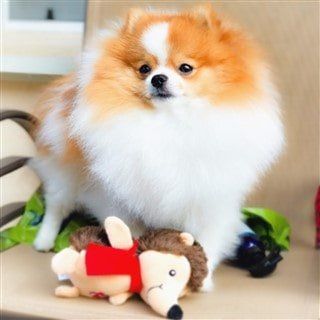
A trim to keep things tidy, protecting the coat with quality shampoos and products,
and using the right brushes when grooming, can all lead to a Pom looking amazing.
Timon, photo courtesy of Laura Montanez
Grooming Tools You Should Not Use on a Pomeranian
- Do not use a bristle brush. This will not damage the coat but will be entirely ineffective since it will not reach through a Pomeranian's dense fur.
- Do not use a spinning rake tool. These are like tiny lawnmowers, meant to thin out an undercoat. You don't want to use this on a Pomeranaian because it pulls out both dead and live hairs. If the undercoat is thinned down in this way, it will not be sufficient enough to hold up the outer-coat which will then lie flat. In addition, any time that this breed's undercoat is cut into, it can be exceedingly difficult to grow back evenly.
- Do not use inferior products. Choosing any old brushes or tools may result in pins without polished tips, cheap plastic that causes static, teeth that break off from combs, and other such issues. When you have a Pomeranian, you have a responsibility to take great care of the coat and that involves having quality brushes and tools.
The 6 Best Grooming Tools for a Pomeranian
#1 A stainless-steel comb, two levels or sides
A Pomeranian should always be combed before they are brushed. The goal is to:
- Separate the hairs. Prepping the coat in this way will help prevent undue stress on the strands of fur once start you start brushing.
- Loosen the undercoat. The undercoat is so thick that combing into it first will help loosen it up for when you want to power through with a brush.
- And to check for mats. Unless you brush your Pom every single day, do not assume that a mat, however small, has not developed.
Stainless-steel is the best type of material for a Pom's comb since it does not cause unnecessary friction with the fur, resists rust, the teeth will not wear down, and there's no possibility of the comb snapping.
Two-levels or two-sided means that one part of the comb has widely-spaced teeth; this is used for a Pomeranian's main body. The other half has narrowly-spaced teeth; this is used for the face, top of the paws, and other small areas. Alternatively, you can use a separate face comb.
Our top recommendation for this sort of comb is the Shiny Pet Stainless Steel Grip Handle Comb . It is nicely sized for both small and large Poms, has rounded teeth so that it won't cause discomfort, and it has a nice rubber grip that helps you keep a firm hold.
. It is nicely sized for both small and large Poms, has rounded teeth so that it won't cause discomfort, and it has a nice rubber grip that helps you keep a firm hold.
#2 A curved mat remover tool
As you carefully comb through the coat to prep it for brushing, you'll be on the lookout for any mats. In most cases, the comb will snag a bit letting you know that you did indeed find something. Don't be surprised; this breed is very prone to mats and unless you brush the coat every single day there is a good chance that you will come upon a tangled piece of fur every now and then.
Whether you find a tangle of long guard hairs (sometimes happens) or a knot of twisted undercoat hairs near the skin (most common), you'll want an easy way to remove the mat without causing any pain.
For tangles near the tips that do not involve any undercoat hairs, you can sometimes work out the knot by hand, after lathering your hands in conditioner to keep things slippery. But, if you and/or your Pomeranian do not have the patience for that, it's okay, you can deal with it as you would with deeper mats. If a mat is deep and down into the coat close to a Pom's skin, the best tool to remove it is a particular mat remover tool.
Most quality mat remover tools are designed to quickly break apart mats without damaging any other part of the coat via very short and sharp blades. It's vital that the blades are razor sharp; if not, hairs will be pulled.
For this grooming tool, our top recommendation is the Safari Mat Remover Dematting Tool . This is sized nicely for small dogs like the Pomeranian, is comfortable to hold, the sharp blades are curved so that skin is not accidentally cut, and it works well for both righties and lefties.
. This is sized nicely for small dogs like the Pomeranian, is comfortable to hold, the sharp blades are curved so that skin is not accidentally cut, and it works well for both righties and lefties.
Tips:
Always use this in the direction of the fur growth, not against it. If the mat is very large, start near the outer edges, working your way toward the center. If you find a mat every time you brush your Pom or routinely find more than one, this is your sign that you are either not brushing deep enough, thorough enough, often enough, or are not using the right brush.
#3 Leave-in conditioning spritz.
Though this is technically a coat product
and not a tool, it must be included in any list of grooming tools for Pomeranians since a good leave-in goes hand-in-hand with brushing. This has the following benefits, helping to:
- Prevent static as you brush
- Prevent split ends
- Lock in moisture to prevent dry fur
- Repel debris like urine splatter, dirt, allergens like pollen, etc.
- Prevent contact friction
- Protect from sun exposure
- Prevent tangles
- Can help keep a Pom smelling nice and clean
So as you can see, there are quite a few reasons to always use a leave-in when you brush. The exact one that you use will depend on what your main goals are. If it's summertime, your Pom is spending a lot of time outside in the sun, and you want to help protect your Pom from UV rays, Chris Christensen Ice on Ice with Sunscreen
 is a good choice.
is a good choice.
If you are looking for something that makes your Pom smell amazing, you may want to opt for Nootie Daily Spritz . There are some amazing fragrances including warm vanilla cookie, cucumber melon, sweet pea & vanilla, and coconut lime verbena.
. There are some amazing fragrances including warm vanilla cookie, cucumber melon, sweet pea & vanilla, and coconut lime verbena.
And if your biggest goal is to help prevent tangles, you can't go wrong with The Stuff Leave-in Conditioner . This can really cut down on grooming time and it is super-effective with all other aspects (repelling debris, split end protection, etc.). The only 'con' is that the scent is not strong; it's a very light apple fragrance.
. This can really cut down on grooming time and it is super-effective with all other aspects (repelling debris, split end protection, etc.). The only 'con' is that the scent is not strong; it's a very light apple fragrance.
No matter which coat product you opt for, if you have a Pom 1+ year old, lightly mist the coat about 1 inch from the roots, section by section as you brush. The brush will help distribute the product down to the tips. If you notice extra-dry tips, you can scrunch in a bit extra by hand on those areas. For young pups, you can spray some leave-in into your palms and work it through the coat by hand.
#4 A small slicker brush.
A properly-sized slicker brush is the best type of brush to use on a Pomeranian for both routine brushing and the brushing that you should do before you give your Pom a bath. It is appropriate for adults and puppies as well since they will soon have their thick double-coats and should get accustomed to this type of brush.
Your main goal is to pull dead hairs out of this breed's tightly-packed-coat, especially deep down from the undercoat, and a slicker brush is designed to do just that. It is also efficient at separating hairs, removing debris from the coat, helping to distribute natural body oil from the roots down toward the tips, and stimulating hair follicles on the skin.
Our top pick for a slicker brush for Pomeranians is the PETPAWJOY Small Slicker Brush . This has several awesome features.
. This has several awesome features.
First, it is square with rounded edges which is much easier to use on a small dog than the many rectangle-shaped brushes on the market. An incredibly helpful feature is that the brush head has 360 degree rotation; since you should always brush in the direction of fur growth, if you don't want to have to move your Pom around as you work your way over the body, you can simply turn the brush head to change the angle of the pins, it'll click and lock with each turn.
The pin tips are coated to help the brush glide through thick coats and to help prevent discomfort when you reach down deep into your Pom's fur. This is also sized very nicely for most Poms; it is even marketed cats and rabbits, aside from small dogs.
Tips:
Brush your Pom at least once a week, but preferably every 3 days. Follow each step before a bath (comb, resolve mats, brush) but you won't spray the coat with a leave-in only to wash the product out moments later. Once you have patted your Pom dry (NEVER rub the coat dry), comb, brush, and spritz. Always brush in the direction of fur growth.
#5 A pin brush, optional.
Once you have combed the coat, taken care of any mats, and used a leave-in spritz along with a slicker brush to go over your Pom's entire body, now what?
You may find that the hairs are not exactly falling the way you'd like and your Pom may look a bit 'unfinished'. This may be particularly relevant if you're about to have visitors or want to take some photos of your little guy or gal.
If so, you may find it helpful to use a small pin brush to go over the coat not with the goal of pulling out dead fur but to straighten out hairs and give the coat a final touch-up.
For this, our top pick is the ConairPRO Small Pin Brush for Dogs . Many pin brushes do not have coated, polished, or bubble tips which can lead to skin irritation and discomfort. But this brush has reinforced stainless-steel pins with soft comfort-tips. The pins are long enough to work well in separating hairs for a finished look but the overall brush is small enough to feel comfortable in your hand and easily make your way around a Pomeranian's body.
. Many pin brushes do not have coated, polished, or bubble tips which can lead to skin irritation and discomfort. But this brush has reinforced stainless-steel pins with soft comfort-tips. The pins are long enough to work well in separating hairs for a finished look but the overall brush is small enough to feel comfortable in your hand and easily make your way around a Pomeranian's body.
#6 A non-rotating rake comb
Rake tools, or combs, are, generally speaking, made to thin out a thick undercoat. It can do this in one of two ways; one of which can damage a Pom's coat and the other which will not, so it's important to know exactly which type of rake tool to use, if you use any at all.
Some rake tools, particularly rotating ones (they resemble little miniature push-reel lawn mowers) are designed to reach deep into a dog's undercoat and thin it dramatically by removing both dead and live hairs. That is okay for some breeds, but not the Pomeranian. If you use that sort of grooming tool on your Pom, there will be insufficient undercoat left to hold up the outer layer guard hairs which will cause the coat to lie flat and lifeless. And, even worse, if the undercoat is cut into in such a way, it can be exceedingly difficult to regrow.
Fixed rake tools, which do not spin like little lawnmowers and are single-rowed, are also designed to reach deep down into a dog's undercoat, but are made to only latch onto and pull out dead shedded hairs, not live ones. And this is the type of grooming tool that can be beneficial to use on a Pomeranian.
There are really only one time in the entire year that you may deem it necessary to use a rake tool like this: the sometimes extraordinarily heavy spring/summer shed that can occur with this breed.
The degree that a Pomeranian sheds depends on many factors including where you live, coat health, age, and more. So, you will need to evaluate your Pom's need for a rake. If you seem to be struggling to remove shedded hairs with the bristle brush and/or your Pom is leaving a trail of fur in the house, you may then want to opt for this to finally remove all the dead winter hairs that would otherwise block air flow to the skin to prep your Pom for the warm and hot weather that is soon to come.
Keeping in mind that the rake MUST be fixed (non-moving), we recommend the Conair Pro Undercoat Rake for Dogs - Medium 3/4 Tooth . Compared to many models, it is the right size for most adult Poms, has a nice grip, and the 3/4" length stainless-steel teeth reach nicely into the undercoat.
. Compared to many models, it is the right size for most adult Poms, has a nice grip, and the 3/4" length stainless-steel teeth reach nicely into the undercoat.
Next:
How to Brush a Pomeranian
- This helpful article summarizes the tools you should have and has step-by-step 'how-to' photos (aside from using a rake for shedding; see below).
You May Also Be Interested In:
Pomeranian Shedding
- What to expect in regard to timing and severity, as well as step-by-step instructions for brushing the coat with an undercoat rake.
The Best Shampoos for a Pomeranian
- What works best, depending on what is happening with your Pom. Covers both routine and specialty shampoos.
The Best Toys for Pomeranians
- For teethers, Poms that are bored, those having troubles being home alone, and for enthusiastic chewers, see what works best.
Pomeranian Feeding Guidelines
- See tips for serving size, wet vs dry, and other elements as well as staying up-to-date regarding the grain vs grain-free debate and other vital info. Includes current recommendations.
If you email photos to us, you agree that PetPom is given free copyright to use at our discretion. We will always credit the photo to the name of the Pom's owner(s) if it is supplied.
Email: Contact@PetPom.com
All text, images and artwork protected by US and International copyright laws. All rights reserved. Copyright PetPom.com
We are a participant in the Amazon Services LLC Associates Program, an affiliate advertising program designed to provide a means for us to earn fees by linking to Amazon.com and affiliated sites.

